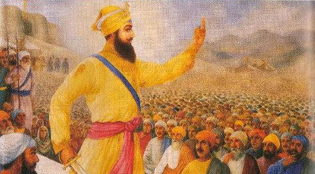Establishment of Khalsa Panth on Baisakhi
 The literal meaning of Khalsa is pure, holy. The tenth Guru of Sikh, Guru
Govinda Singh, established today the Khalsa Panth. The sole aim of establishing
this Panth was, to free from the atrocities of Mughal emperors of that time. To
finish the feeling of inequality also, he gave a title of “Panch Pyare” on the
day of Baisakhi. These Panch Pyare were of different caste. They are fed with
Amrit(sacred nectar of immortality), and got the title of Singh for himself
after drinking Amrit from there hands. This way, today Guru Govinda Singh gave
a religious enlightening to Sikha people as well as gave a new form to the
religious beliefs to societies. This day, in Gurudwara especially in Anandpur
Sahib, Ardas, Shabad and Kirtans are done with distribution of Prasad and
arrangement of Langar is done.
The literal meaning of Khalsa is pure, holy. The tenth Guru of Sikh, Guru
Govinda Singh, established today the Khalsa Panth. The sole aim of establishing
this Panth was, to free from the atrocities of Mughal emperors of that time. To
finish the feeling of inequality also, he gave a title of “Panch Pyare” on the
day of Baisakhi. These Panch Pyare were of different caste. They are fed with
Amrit(sacred nectar of immortality), and got the title of Singh for himself
after drinking Amrit from there hands. This way, today Guru Govinda Singh gave
a religious enlightening to Sikha people as well as gave a new form to the
religious beliefs to societies. This day, in Gurudwara especially in Anandpur
Sahib, Ardas, Shabad and Kirtans are done with distribution of Prasad and
arrangement of Langar is done.
History of vaisakhi - April, 1699
To understand the importance of Khalsa Panth, we will need to go back to the history April 1699. As per the order of Guru, on the day of Baishaki, a bed was decorated in Anandpur Sahib. The whole of Sikh community was gathered here. That time, the tenth Guru, Sri Guru Govinda Singh stood up and asked for five head to save humanity. Listening this, the gathered public got motionless.
From that crowd, a Sikh got up with courage and volunteered, saying to save his religion he is ready to give his head. His name was Daya Ram. Guru ji took Daya Ram inside a tent, and after sometime, Guru came out with a sword having blood on it. Then he asked for a new head, and the process followed for five times. Each time Guru ji used to take the person taking initiative inside the tent and return with a sword of blood.
Fifth time everyone saw, the five Sikh came out of tent wearing Sri Sahib dress. Tenth Guru christened them “Panch Pyare” and made them taste Amrit, and gave them recognition as Sikh. From that day guru made it compulsory for Sikh's to have a Kesh (long hair), Kangha (comb), Kara (bracelet), Kachha (shorts) and Kripan (dagger). This way, the foundation of Khalsa Panth was laid down.
Best Day for Tasting Nectar in Sikkhism
On the day of Baisakhi, Guru Govinda Singh made his pupils to taste Amrit (sacred nectar of immortality), also, tasted Amrit from their hands. So, there is special tradition of tasting Amrit on this very day. Although, in Khalsa Panth, Amrit is tasted on other days as well, but as compared to the rest of the days, this day has more relevance.
Festival of Baisakhi don’t just have religious significance but, also spiritual importance. This festival gives us a lesson that in the fight of good and evil, it is always good and kindness which wins. This day Guru Govinda Singh gave his disciples the lesson of following a path of goodness and kindness as well as staying away from evil and bad works.
According to Guru Govinda Singh, following the path of spirituality and leading a new life is the the work of kindness(Naiki). On this day, in all the Gurudwara of our country, monolithic recitations are performed. And, Amrit is tasted.
On the day Guru Govinda Singh founded Khalsa Panth, sun was entering Aries sign, and sun on 13th and 14th April goes in Aries sign.
Three Sects of Sikhism
From Guru Nanak to Guru Govind Singh, all the ten Guru preached some things to follow. To follow them, is the duty of every Sikh. The whole of Sikh community is divided into three parts.
- Sikh Sangat- Sikh Sangat include the people who follow the preachings of guru, and consider Guru Granth Sahib as there eleventh Guru.
- Khalsa Samaj- Khalsa Samaj owns the admin rights of Sikh. Guru Govinda Singh established this samaj and stated some rules and regulation for them that are mandatory to be followed.
- Nihang Khalsa- Tenth Guru Maharaja, as per the tradition of that era, chose a part of Khalsa samaj, Nihang Sikh, and gave them the work of protecting religious devotees. These people are always in an outfit of soldier.


